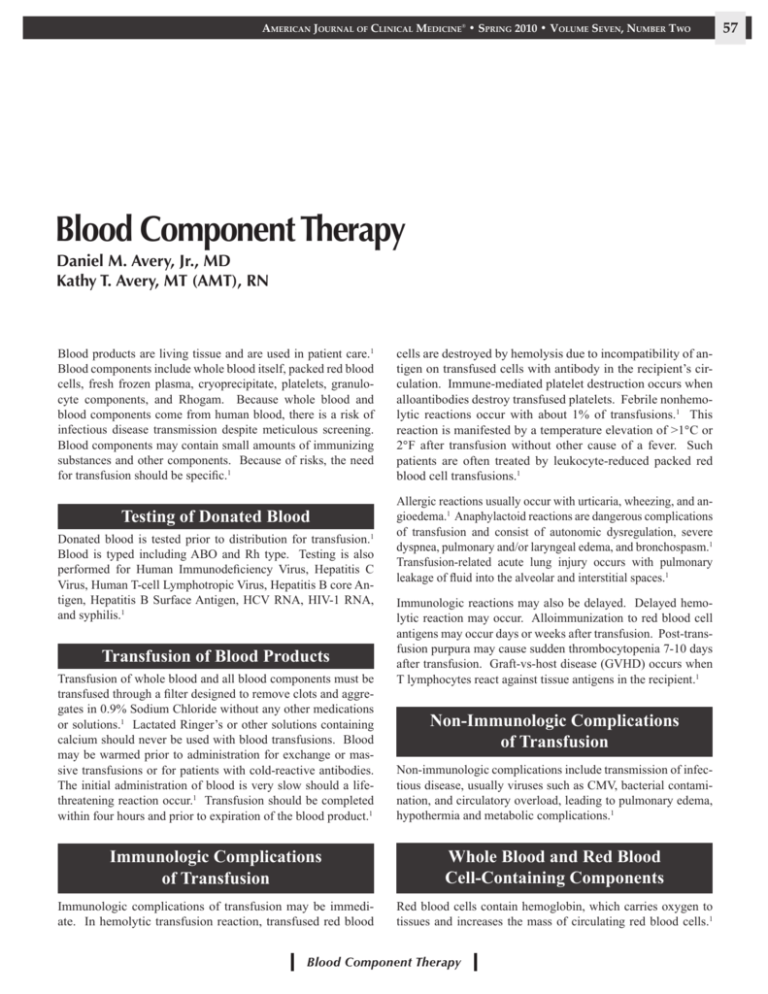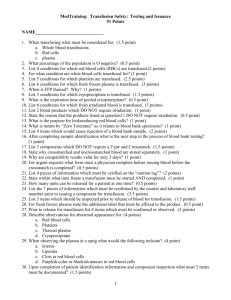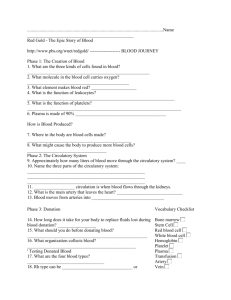Blood Component Therapy
advertisement

American Journal of Clinical Medicine® • Spring 2010 • Volume Seven, Number Two Blood Component Therapy Daniel M. Avery, Jr., MD Kathy T. Avery, MT (AMT), RN Blood products are living tissue and are used in patient care.1 Blood components include whole blood itself, packed red blood cells, fresh frozen plasma, cryoprecipitate, platelets, granulocyte components, and Rhogam. Because whole blood and blood components come from human blood, there is a risk of infectious disease transmission despite meticulous screening. Blood components may contain small amounts of immunizing substances and other components. Because of risks, the need for transfusion should be specific.1 Testing of Donated Blood Donated blood is tested prior to distribution for transfusion.1 Blood is typed including ABO and Rh type. Testing is also performed for Human Immunodeficiency Virus, Hepatitis C Virus, Human T-cell Lymphotropic Virus, Hepatitis B core Antigen, Hepatitis B Surface Antigen, HCV RNA, HIV-1 RNA, and syphilis.1 Transfusion of Blood Products Transfusion of whole blood and all blood components must be transfused through a filter designed to remove clots and aggregates in 0.9% Sodium Chloride without any other medications or solutions.1 Lactated Ringer’s or other solutions containing calcium should never be used with blood transfusions. Blood may be warmed prior to administration for exchange or massive transfusions or for patients with cold-reactive antibodies. The initial administration of blood is very slow should a lifethreatening reaction occur.1 Transfusion should be completed within four hours and prior to expiration of the blood product.1 cells are destroyed by hemolysis due to incompatibility of antigen on transfused cells with antibody in the recipient’s circulation. Immune-mediated platelet destruction occurs when alloantibodies destroy transfused platelets. Febrile nonhemolytic reactions occur with about 1% of transfusions.1 This reaction is manifested by a temperature elevation of >1°C or 2°F after transfusion without other cause of a fever. Such patients are often treated by leukocyte-reduced packed red blood cell transfusions.1 Allergic reactions usually occur with urticaria, wheezing, and angioedema.1 Anaphylactoid reactions are dangerous complications of transfusion and consist of autonomic dysregulation, severe dyspnea, pulmonary and/or laryngeal edema, and bronchospasm.1 Transfusion-related acute lung injury occurs with pulmonary leakage of fluid into the alveolar and interstitial spaces.1 Immunologic reactions may also be delayed. Delayed hemolytic reaction may occur. Alloimmunization to red blood cell antigens may occur days or weeks after transfusion. Post-transfusion purpura may cause sudden thrombocytopenia 7-10 days after transfusion. Graft-vs-host disease (GVHD) occurs when T lymphocytes react against tissue antigens in the recipient.1 Non-Immunologic Complications of Transfusion Non-immunologic complications include transmission of infectious disease, usually viruses such as CMV, bacterial contamination, and circulatory overload, leading to pulmonary edema, hypothermia and metabolic complications.1 Immunologic Complications of Transfusion Whole Blood and Red Blood Cell-Containing Components Immunologic complications of transfusion may be immediate. In hemolytic transfusion reaction, transfused red blood Red blood cells contain hemoglobin, which carries oxygen to tissues and increases the mass of circulating red blood cells.1 Blood Component Therapy 57 58 American Journal of Clinical Medicine® • Spring 2010 • Volume Seven, Number Two Red blood cell components are indicated for the treatment of symptomatic deficit of oxygen-carrying capacity and exchange transfusion.1 Red cell transfusions should not be used to treat anemias that can be corrected with specific medications, such as iron, folate, and B12. Whole blood is rarely kept in hospital blood banks, because the collection process is more rigorous, the shelf life shorter, and the risk of reaction greater because of all of the components. Whole blood contains red blood cells and plasma components of circulating blood. A single whole blood donation contains 450500 mls of blood with a minimum hematocrit of 38%.1 Shelf life of whole blood is 21-35 days, depending on the anticoagulant/preservative.1 When the plasma is removed, red blood cells remain and have a hematocrit of 65-80% and a volume of 225350 mls.1 Additive solutions mixed with the red cells result in a hematocrit of 55-65% and a volume of 300-400 mls.1 Each unit of whole blood or packed red blood cells contains sufficient hemoglobin to raise the hemoglobin concentration in an average size adult by 1 g/dL and the hematocrit by three percentage points. The increase is less in an obese person. Blood is typed and cross-matched prior to administration to make sure that it will be compatible. The only exception to this is when any delay in transfusion would be life threatening. O negative blood is the universal donor and may be given when there is no time for a type and cross-match. In life-threatening emergencies any blood type may have been given in hopes of saving the patient from exsanguination and dealing with transfusion reactions and complications if the patient survives. Rhogam may need to be given if a Rh negative patient receives Rh positive blood. In life-threatening hemorrhage a patient may know his blood type, so that type-specific blood may be administered. An obstetric patient that has had prenatal care will have had a type, Rh, and antibody screen performed as part of initial prenatal laboratory studies. Type-specific blood could also be administered to this patient. Fresh Frozen Plasma contains all of the coagulation factors.1 In massive blood loss and blood component replacement, one unit of FFP is transfused for each two to three units of packed red blood cells. Cryoprecipitate Components Cryoprecipitate AHF is prepared by thawing FFP and recovering the precipitate. It contains coagulation Factor VIII, Factor XIII, Fibrinogen, vWF, and Fibronectin. Each unit of Cryoprecipitate AHF contains >80 IU Factor VIII and > 150 mg of fibrinogen.1 Cryoprecipitate is indicated for therapy in von Willebrand disease, hemophilia A (Factor VIII deficiency), and bleeding associated with fibrinogen deficiency.1 Administration of Cryoprecipitate When cryoprecipitate is administered, ABO compatibility is preferred without consideration of Rh status. Compatibility testing is unnecessary. Thawed cryoprecipitate is given as soon as possible after thawing.1 The cryoprecipitate is mixed well with 10-15 mls of 0.9% Sodium Chloride. Platelet Components Platelets are essential for normal hemostasis and work through a series of reactions inducing platelet adherence to vessel walls and platelet activation leading to platelet aggregation and formation of a primary hemostatic plug.1 Platelet transfusions are indicated for the treatment of bleeding associated with decreased numbers of platelets, usually less than 50,000.1 Platelet transfusion is not indicated when the count is >100,000. Platelets are not effective in disorders which destroy circulating platelets, such as ITP.1 One unit of platelets is a concentrate of platelets separated from a single unit of whole blood in 40-70 mls of plasma containing 5.5 X 10 to the tenth power platelets.1 Transfusion of Platelets Plasma Components Fresh Frozen Plasma (FFP) is obtained from whole blood or apheresis and frozen at -18 degrees or colder. FFP contains functional amounts of Coagulation Factors V and VIII.1 FFP is indicated in massive transfusion with coagulation deficiencies, active bleeding with patients on coumadin or who need to undergo an invasive procedure before Vitamin K could reverse the anticoagulant effect, transfusion or plasma exchange in patients with TTP, management of selected coagulation factor deficiencies when coagulation concentrates are unavailable, or management of rare specific plasma protein deficiencies.1 Transfusion of Fresh Frozen Plasma Fresh frozen plasma must be ABO compatible with the recipient’s red blood cells, but compatibility testing is not necessary.1 Compatibility testing is not necessary when transfusing platelets.1 One unit of platelets should increase the platelet count by 5-10,000 in a normal size adult and by 20,000 in an 18 kg child.1 The administration dose is 4-8 units.1 Platelets can be infused quickly but not in less than four hours.1 Granulocyte Components Granulocyte concentrates are collected by hemapheresis.1 Granulocyte transfusion therapy is controversial.1 The number of granulocytes in the concentrate is >1.0 x 10 to the tenth power. Infused granulocytes kill bacteria and fungi. A granulocyte infusion does not increase the patient’s granulocyte count but is used to treat neutropenia (<500) in patients with infections who have not responded to antibiotics and in whom eventual bone Blood Component Therapy American Journal of Clinical Medicine® • Spring 2010 • Volume Seven, Number Two marrow recovery is expected.1 Red blood cells leukocyte reduced or leukocyte poor red blood cells are used to decrease febrile nonhemolytic transfusion reactions.1 Leukocyte reduced blood components may cause severe hypotension in patients, especially those on ACE inhibitors.1 Transfusion of Granulocytes Granulocytes should be transfused as soon as possible. The red blood cells in the infusion should be ABO compatible. Therapy should be continued daily until infection and fever are resolved, and the absolute granulocyte count returns to at least 500.1 Because most patients receiving this transfusion are immunocompromised, granulocytes should be irradiated to prevent graftversus-host disease.1 Rhogam Rhogam or Rh Immune Globulin is used to prevent the development of antibodies to red blood cell antigens following exposure to such antigens from another individual, such as a transfusion or pregnancy.2 A person that lacks a specific red blood cell antigen can produce an antibody when exposed to it.3 These antibodies can cross the placenta and hemolyze fetal red blood cells, leading to anemia.2 Antibodies can also form with Kell, Duffy, and Kidd antigens. Anti-Lewis and Anti-I usually do not cause problems.2 Anti-Kell is the most important non-Rh cause of hemolytic anemia. Rh Immune Globulin is given to prevent active antibody response by passive immunization.2 Rhogam only works for the D antigen. The standard dose is 300 micrograms, which will neutralize 15 mls of fetal red blood cells. The amount of Rhogam needed is determined by the Kleihauer-Betke Test.2 Rhogam is usually given within 72 hours of delivery but can be given up to four weeks. Daniel M. Avery, Jr., MD, is Associate Professor, Department of Obstetrics & Gynecology, College of Community Health Services, University of Alabama School of Medicine, in Tuscaloosa. Kathy T. Avery, RN, BA, MT (AMT), is Clinical Nursing Supervisor for the University of Alabama Student Health Center. Potential Financial Conflicts of Interest: By AJCM policy, all authors are required to disclose any and all commercial, financial, and other relationships in any way related to the subject of this article that might create any potential conflict of interest. The authors have stated that no such relationships exist. ® References 1. Circular of Information. American Association of Blood Banks, America’s Blood Centers and the American Red Cross. 2007. 2. Beckmann CRB, Ling FW, Smith RP et al. Obstetrics and Gynecology, 5th Edition. 2006, 136-138. 3. Cunningham FG, Leveno KJ, Bloom SL et al. Williams Obstetrics, 22nd Edition. 2006, 663. Blood Component Therapy 59









